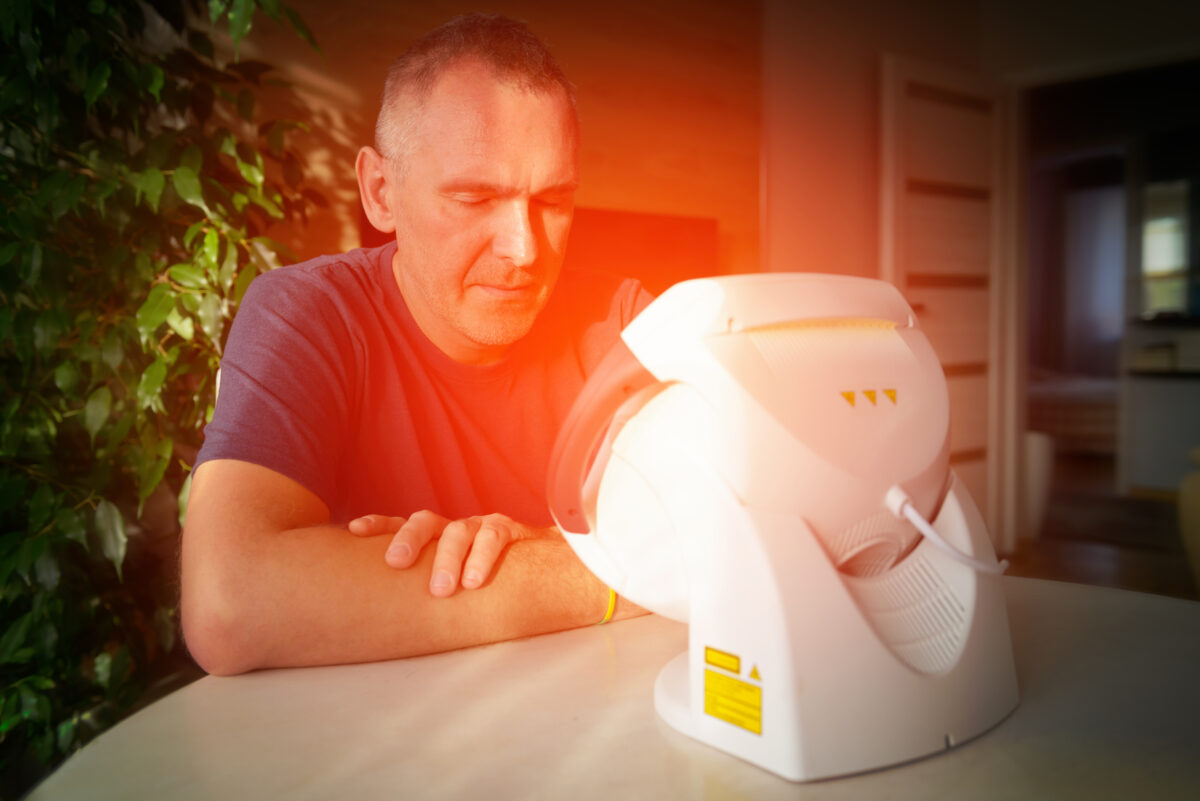


Degenerative neurological disorders, such as dementia and Alzheimer’s, can significantly affect an individual’s cognitive abilities and overall quality of life. While there is currently no cure for these conditions, researchers are exploring new treatments that may help slow the conditions’ progression or alleviate specific symptoms.
One treatment that has shown promise is light therapy.
Phototherapy, also called light therapy, involves using specific wavelengths of light to stimulate cells in the body. A meta-analysis suggests that phototherapy may be “one of the most promising non-pharmacological interventions for improving core symptoms of dementia.”
The studies included older adults of all ages with various types of dementia, including Alzheimer’s, vascular dementia, dementia with Lewy bodies, Parkinson’s, and mixed type/other causes.
Isabella Park, DO, associate medical director and director of geriatrics and palliative care for Northwell Long Island Jewish Forest Hills, told The Epoch Times that the study findings suggest that phototherapy can significantly improve cognitive function—including memory, attention, and executive function—in patients with dementia.
“The positive effects were observed in both short-term and long-term interventions,” she noted but also cautioned that phototherapy shouldn’t be used as a substitute for other treatments for dementia, such as medication and behavioral therapies.
Although the field is still in its early stages, there is growing evidence to suggest that phototherapy may be effective in improving cognitive function and reducing symptoms of cognitive decline.
One of the main ways that phototherapy works is by reducing inflammation in the brain. Inflammation is a crucial contributor to many neurological disorders, including Alzheimer’s.
Research based on animal models shows that phototherapy can help reduce brain inflammation, which may slow the progression of neurodegenerative diseases.
Another way that phototherapy may help is by improving mitochondrial function. Mitochondria play a crucial role in the health of brain cells and are considered the “powerhouses” of cells.
Studies involving animals have shown that a specific type of phototherapy, known as transcranial photobiomodulation (tPBM), can help improve mitochondrial function, which may lead to better cognitive function and a slower progression of degenerative neurological disorders.
Therapy involves shining near-infrared light on the scalp, which is believed to penetrate the skull and stimulate brain cells.
Researchers at the University of Birmingham in the United Kingdom and Beijing Normal University in China have found that this non-invasive therapy could improve short-term and working memory in people by about 10 percent. Dongwei Li, a visiting PhD student at the University of Birmingham’s Centre for Human Brain Health and study coauthor, said in a statement that this type of treatment “is safe, simple and non-invasive, with no side-effects.”
In the study, 90 male and female participants between the ages of 18 and 25 were treated with laser light beamed through their scalps to the right or left prefrontal cortex at 1064 nm wavelengths. They were also administered a placebo to confirm the effect observed with treatment.
After more than 12 minutes, participants were given memory tests. Those who received the treatment showed clear memory improvements compared to the untreated group.
A recent systematic review of studies found that a combination of tPBM and visual stimulation (VS) with particular wavelengths had measurable benefits.
“Human studies performed so far support the use of PBM at 810-870 nm light pulsing at 40 Hz for improving brain network connectivity and memory in older subjects and AD [Alzheimer’s disease] patients, while 40 Hz VS in humans seems to improve cognition,” the study authors concluded.
Another type of phototherapy studied is bright light therapy, which involves exposing individuals to bright light for a set period each day.
While bright light therapy has been primarily studied as a treatment for seasonal affective disorder, one study suggests that it may also help improve cognitive function in individuals with dementia.
The study authors found that a bright light therapy intervention program of 30-minute sessions “provides promising outcomes and immediate positive effects on mood, stimulation level, blood oxygen saturation, and heart rate.”
According to Yuko Hara, PhD, director of aging and prevention at the Alzheimer’s Drug Discovery Foundation, people with dementia often have disruptions in their sleep-wake cycles.
“A few small studies have suggested that light exposure or light therapy benefit for dementia patients by enhancing visual sensory inputs to stimulate specific cells in the hypothalamus that regulate the circadian rhythm,” Hara said.
One reason this treatment shows promise could be related to its effect on an agitated state of confusion called sundowning which happens to some people with dementia towards the end of the day.
“Adjusting lighting is one of the ways in which you can prevent or better cope with sundowning,” Hara said. “Exposure to natural bright light in the morning and softer room lighting in the evening may help regulate one’s circadian rhythm,” she added. This can also improve sleep patterns for people with dementia. Poor sleep is associated with worse memory in people with dementia, and sleep medications, according to some research, may do more harm than good.
“Sleep-promoting medications are not recommended due to increased risks of falls, drug interactions, and other adverse events,” Hara said. “Light therapy, on the other hand, is generally safe.”
Although the use of phototherapy for the treatment of degenerative neurological disorders is still relatively new—and the results have been promising—it’s important to remember that more research is needed to fully understand how it can best be used to treat these conditions.
While phototherapy may be a viable option for some individuals, it’s essential to weigh the potential benefits and risks, such as possible skin irritation and sleep disturbance if used at the wrong time of day, before making any treatment decisions. The hope is that with continued research and innovation, new treatment options will be developed that improve the lives of people who have degenerative neurological disorders.
